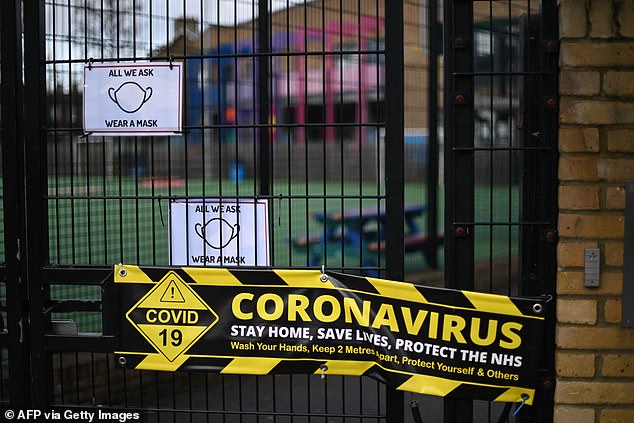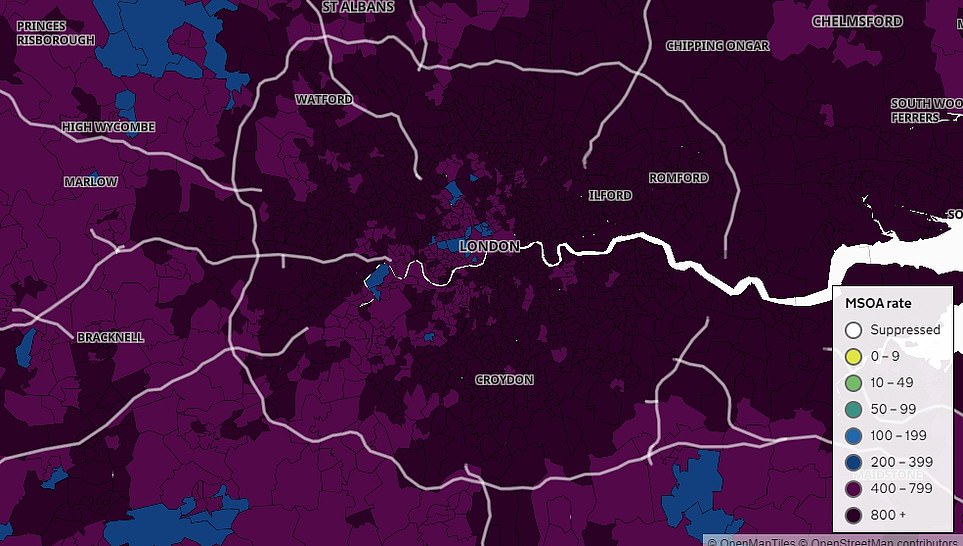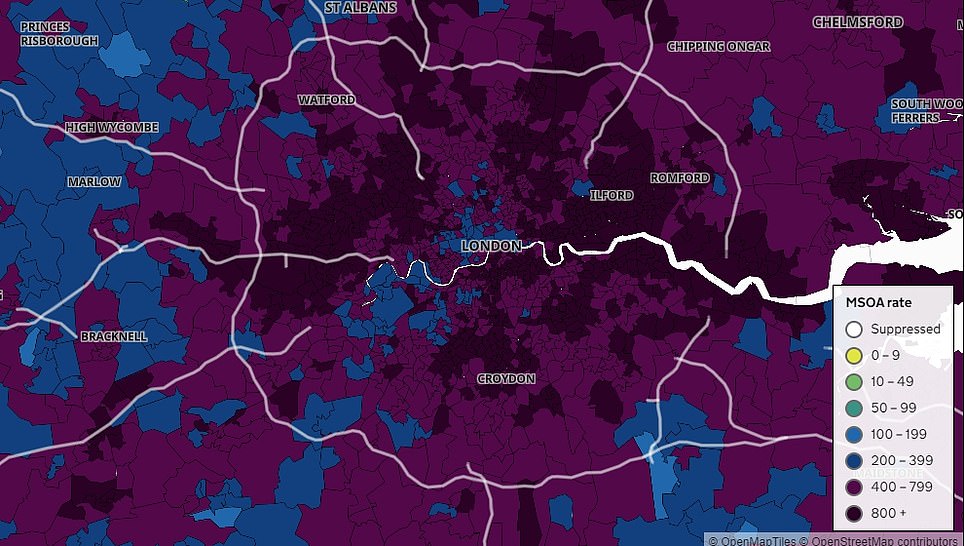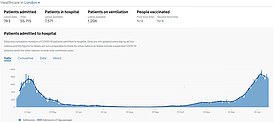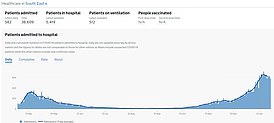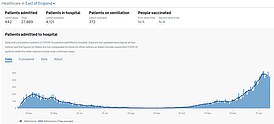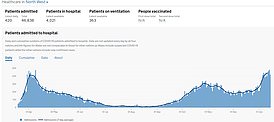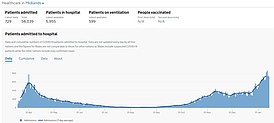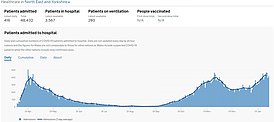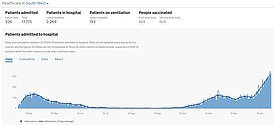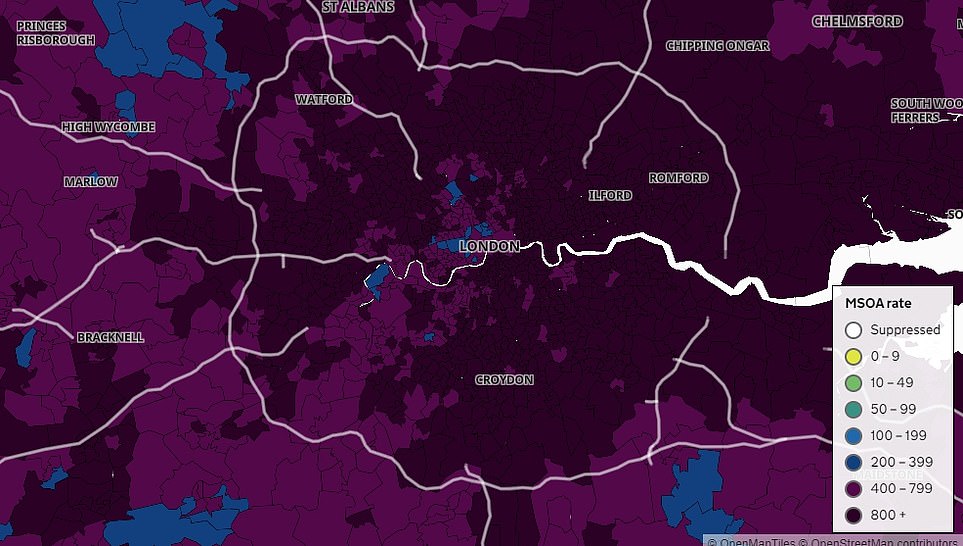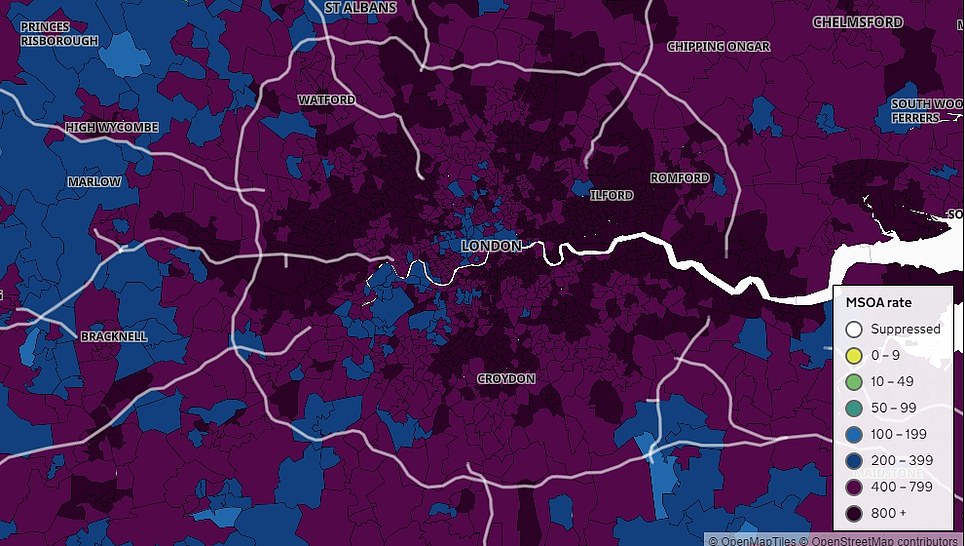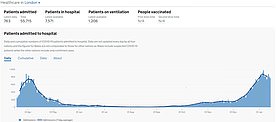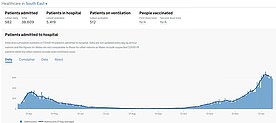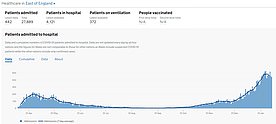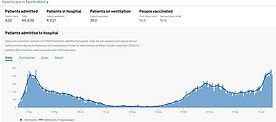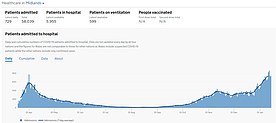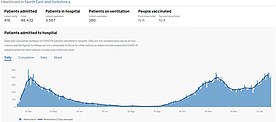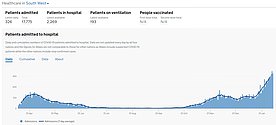Covid UK: Schools could be closed until after EASTER
Schools could remain closed until the Easter holidays, with children facing another three months away from the classrooms, educations chiefs now fear.
Despite the UK recording another drop in Covid cases, school bosses believe millions of pupils could face being home schooled until the start of April.
Fears were further compounded as Foreign Secretary Dominic Raab warned at the weekend that it would not be possible to start to lift lockdown restrictions in England until March.
And yesterday Health Secretary Matt Hancock cast more doubt on a March re-opening when he declined to say that this meant schools would reopen in early Spring.
The warning comes as disgruntled Tory MPs last night demanded the Government produce an urgent ‘road map’ out of lockdown – which is due to be lifted in mid-February.
But as the number of people vaccinated reached 4million yesterday and infection figures continued to drop, with Britain recording another 37,535 new cases, down a fifth from last Monday, Boris Johnson defied fresh demands to say how and when the brutal restrictions in England will ease.
Meanwhile, Government sources last night said it was too early to say when schools would reopen.
One source said: ‘It’s about what the health picture is. If lockdown does its job then schools could be the first thing to open.’
The Prime Minister has said reopening schools will be his priority when lockdown is eased – but no date has ever been set.
However the leader of a major academy chain warned the ‘mood’ was for schools to shut until the Easter holidays – which are at the start of April.
Steve Chalke, head of the Oasis academy chain, which runs 48 schools, said: ‘I don’t think schools will reopen until post Easter. I think they will miss the second half of term as well.’
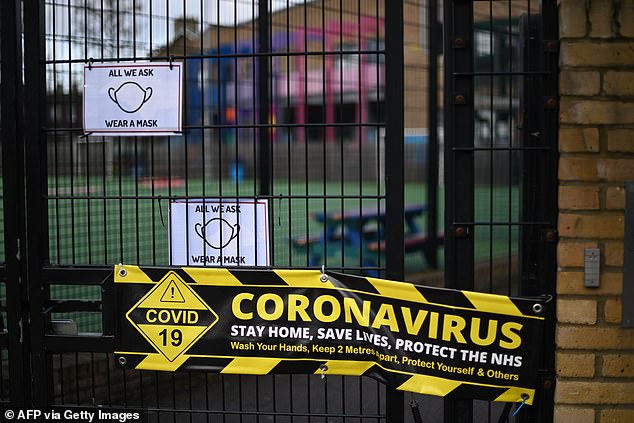
Fears of schools remaining shut until Easter are growing after ministers refused to set a reopening date yesterday. Pictured, a primary school in east London
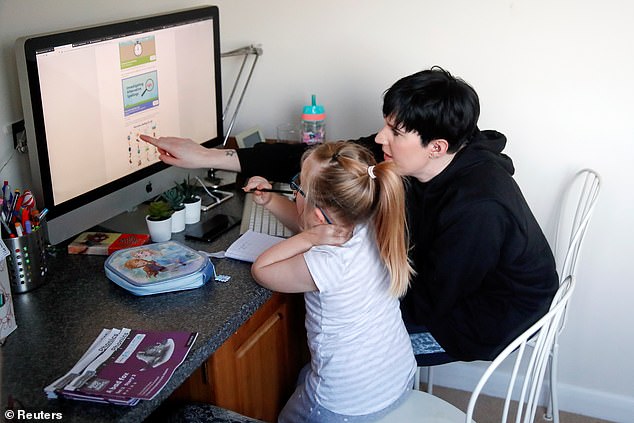
Charlotte Rose assists one of her children, who is home schooled in Milton Keynes
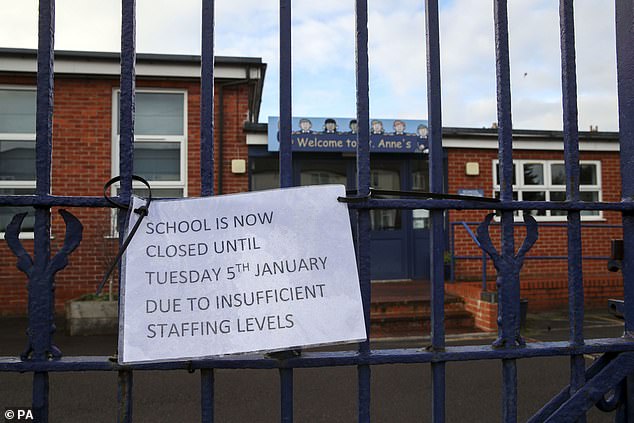
A sign hangs on the gate of St Anne’s Catholic Primary school in Caversham, Reading
He said many teachers are very worried about catching Covid in school and that they will feel ‘safer’ and ‘more confident’ when the weather warms up and they can take children out of the classroom more.
At yesterday’s Downing Street press conference, Mr Hancock was asked whether schools would reopen in March.
He simply said: ‘We’ve got to watch the data, and the Prime Minister, when he brought in the national lockdown, set out four considerations. We’ve got to see the number of deaths coming down, and sadly we haven’t seen that yet. We need to clearly see the pressure on the NHS reducing, and we are not seeing that yet.
‘We must see the vaccination programme working and the rollout is going really well.’ He continued: ‘The fourth consideration is that there mustn’t be some other new variant.’
Professor Susan Hopkins, senior medical adviser at Public Health England, said: ‘We’ve always said the schools should be the last to close and first to open.
‘But I think giving a more defined date than that is very difficult until we see what happens over the next few weeks.’
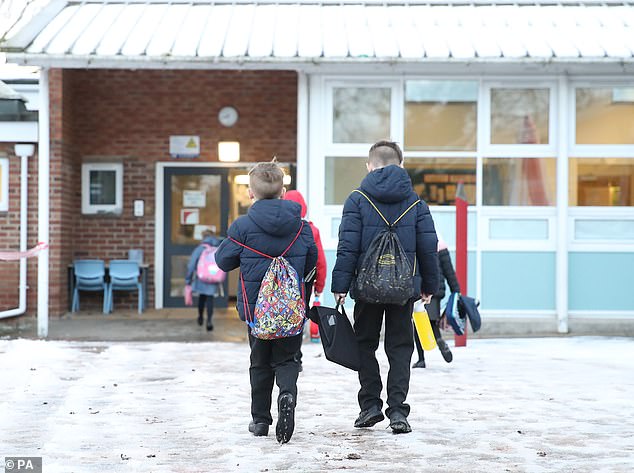
Education insiders said the date for reopening ‘was never going to be’ February half-term and claimed the Government is ‘working on the assumption it will be Easter at the earliest’
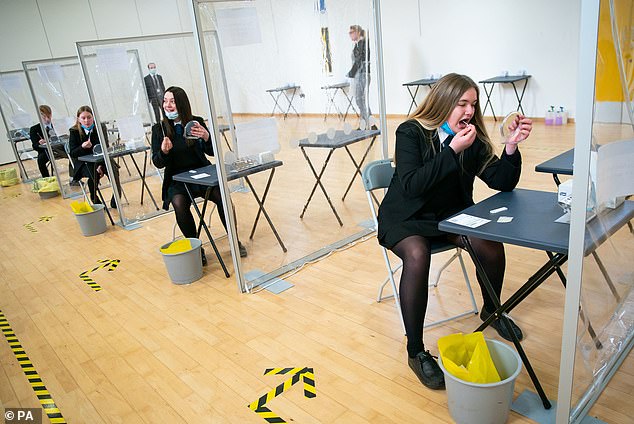
Students takes a COVID-19 test at Oasis Academy in Coulsdon, Surrey
Last night Robert Halfon, Tory MP and chairman of the education committee, said: ‘The Government said that schools would reopen after the February half term. Everything possible should be done to keep to that date – for the sake of the children’s education, mental health and safety.
‘That is why ministers should prioritise school staff for the vaccine, and send in mobile units to jab them across the country.’
Yesterday Mr Johnson said there would be no ‘open sesame’ relaxation of lockdown. ‘I understand completely that people want to get back to normal as fast as we possibly can,’ he said.
The Prime Minister insisted that things would look ‘very different by the spring’, adding: ‘I’m afraid I’ve got to warn people it will be gradual, you can’t just open up in a great open sesame, in a great bang, because I’m afraid the situation is still pretty precarious.’
It comes as the PM defied fresh demands from Tory MPs for a ‘road map’ out of lockdown today as coronavirus infections tumbled again.
In other coronavirus developments:
- The Covid-19 mass vaccine programme will not have an impact on hospital admissions or death rates until ‘well into February’, national medical director for NHS England Stephen Powis warned today;
- Ministers are facing a major Tory revolt over whether to extend the £20 a week uplift to Universal Credit during pandemic;
- First Minister Mark Drakeford has defended the slower rollout of the vaccination programme in Wales – saying the Pfizer vaccine could not be used all at once;
- Matt Hancock told a Downing Street briefing there should be a ‘national debate’ on which groups should be prioritised for the vaccine once the over-50s have received the jab;
- Coronavirus was the leading cause of death in England last year and accounted for one in eight fatalities, official data has revealed;
- There has been chaos at airports as the new rules on negative tests came into force.
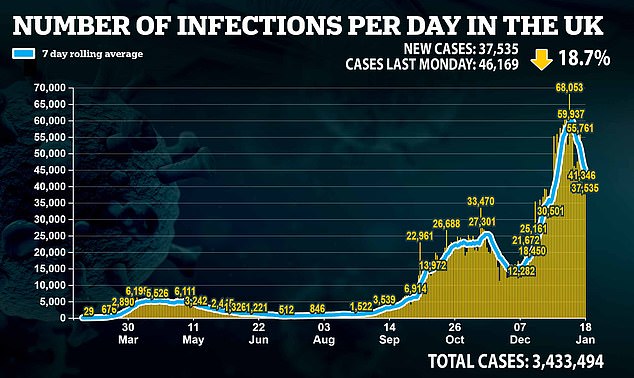
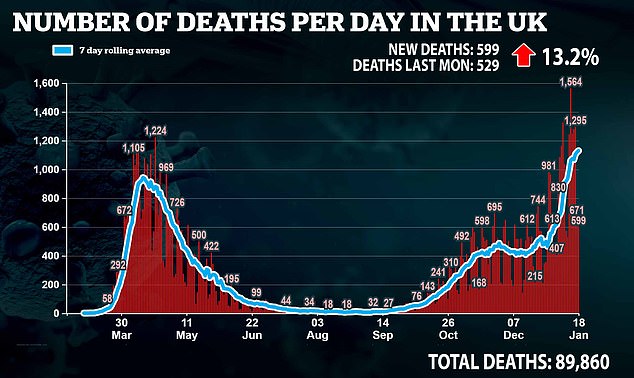
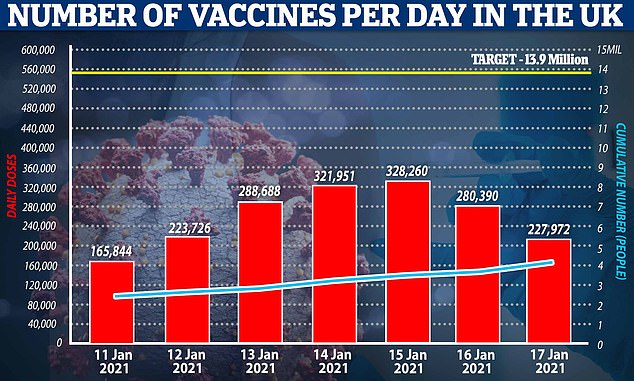
The PM is under pressure to say how and when the brutal restrictions in England will ease after the UK recorded another 37,535 cases – down a fifth from last Monday.
Although deaths rose again to 599 there are increasing signs that the curve is flattening, as it lags weeks behind the new infections.
Conservatives this evening underlined calls from former chief whip Mark Harper, who heads the CRG group of lockdown-sceptics, to say what will happen when the government has vaccinated the four most vulnerable groups – meant to happen by mid-February.
The number of people receiving their first jab topped four million today.
The deputy chair of the group, Steve Baker said: ‘We locked down the country and shut down our schools on the basis of a forecast, so why can’t we open it up on the basis of one too? It is not sustainable to leave the public and British businesses languishing any longer.
‘Businesses and individuals desperately need hope and the opportunity to plan our recovery, that’s why we need to know our road to recovery as soon as possible.’
Another Tory backbencher told MailOnline the government should lay out its plans even if it is like ‘snakes and ladders’ and the arrangements later have to change.
However, Mr Johnson poured cold water on the idea this afternoon, insist
ing that it will not be possible to set out the route for unwinding restrictions until February 15.
Touring the Oxford Biomedica vaccine plant, the PM also warned when the loosening does come it will not be an ‘open sesame’ moment.
‘I understand completely that people want to get back to normal as fast as we possibly can. It does depend on things going well,’ he said.
‘It depends on the vaccination programme going well, it depends on there being no new variants that throw our plans out and we have to mitigate against, and it depends on everybody, all of us, remembering that we’re not out of the woods yet.’
He said: ‘We’re going as fast as we can but I stress we can do everything we can to open up but when we come to February 15, and the moment when we have to take stock of what we’ve achieved, that’s the time to look at where the virus is, the extent of the infection and the success that we’ve had.
‘It’s only really then that we can talk about the way ahead and what steps we can take to relax.
‘I’m afraid I’ve got to warn people it will be gradual, you can’t just open up in a great open sesame, in a great bang, because I’m afraid the situation is still pretty precarious.’
The wrangling came as ministers face a backlash over a vaccination ‘postcode lottery’, with millions of 70-somethings being offered a jab – but only in areas where the ‘majority’ of over-80s have had it already.
Nearly 5million people aged between 70 and 80 are being invited to receive their first dose, with some in Whitehall suggesting the rollout is going so well that the wider adult population could be covered by June rather than September.
However, vaccines minister Nadhim Zahawi said people in their 70s will only be offered jabs in areas where the ‘majority’ of over-80s have already had their first shot.
That could mean people in areas such as London and Suffolk, where progress has been slower, will have to wait longer.
Has London beaten the second wave of Covid? Dramatic map shows how infections are falling in EVERY borough, hospital cases continue to drop and deaths began falling last week
Luke Andrews and Connor Boyd Assistant Health Editor and Jack Wright for MailOnline
London’s devastating winter wave of coronavirus appears to have passed its peak, as official data shows infections were falling in all 32 boroughs last week and deaths and hospital admissions have begun to plateau.
Scientists say the promising figures are proof that tough Tier Four curbs were driving down the spread of the super-infectious Kent strain of the virus before the national lockdown.
Public Health England figures show cases fell in every borough of the capital over the seven days to January 12, with the London-wide infection rate plummeting by more than a quarter.
The trends in data earlier this month could not have been triggered by the national lockdown that came into force on January 4 because it takes about three weeks for draconian curbs to drive down infections and cases. It suggests Tier Four was turning the tide on the capital’s second wave, but experts say the tiered approach was bolstered massively by the fact schools were closed for the festive break.
It suggests Tier Four was turning the tide on the capital’s second wave, but experts say the tiered approach was bolstered massively by the fact schools were closed for the festive break.
Both regions are also recording a slowdown in cases and hospitalisations, but deaths are only plateauing in the East of England. Scientists say they expect deaths to also flatline in the South East by the end of this week.
In another sign Britain has turned the tide on the second wave Covid-19 hospitalisations are now only surging in the South West, which enjoyed the fewest curbs on daily life under the tiered system.
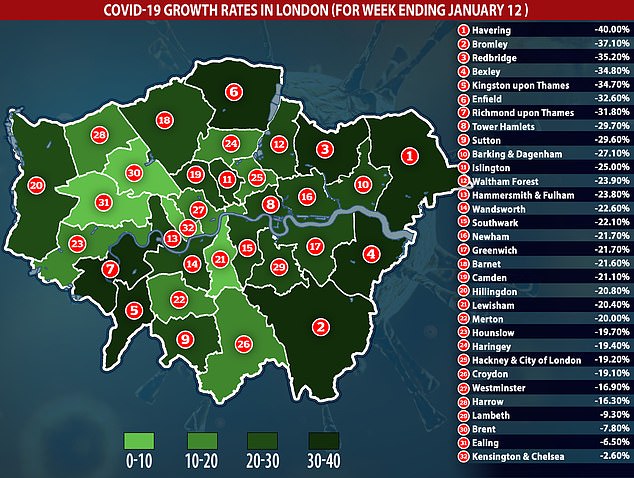
Department of Health figures show how weekly infection rates — the number of positive tests per every 100,000 people — changed in the seven-day spell ending January 12, compared to January 5
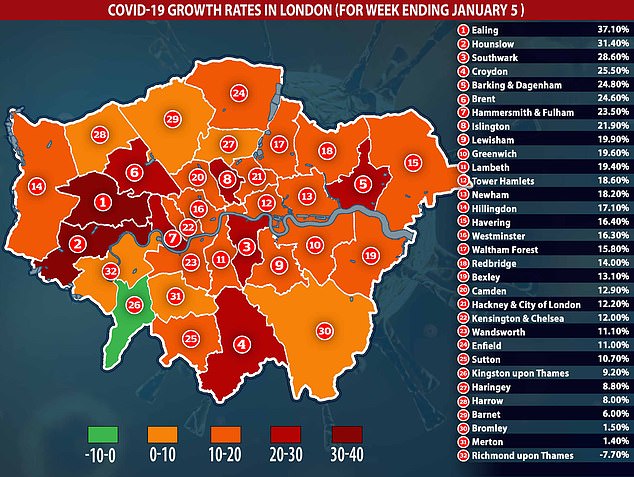
Department of Health figures show how weekly infection rates — the number of positive tests per every 100,000 people — changed in the seven-day spell ending January 5, compared to December 29
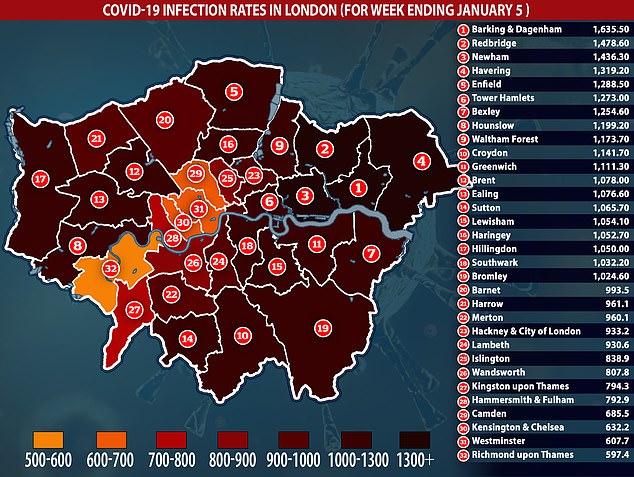
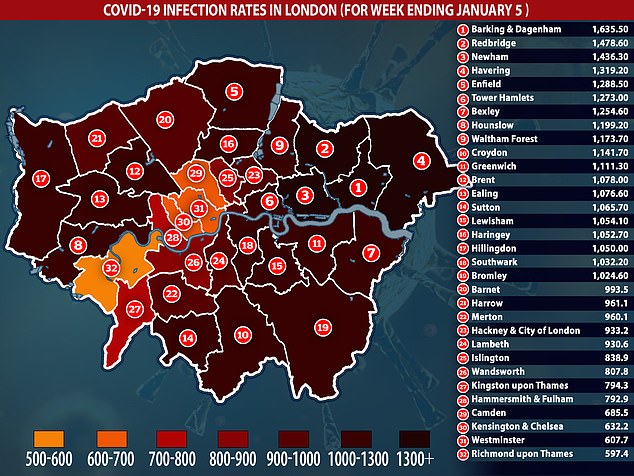
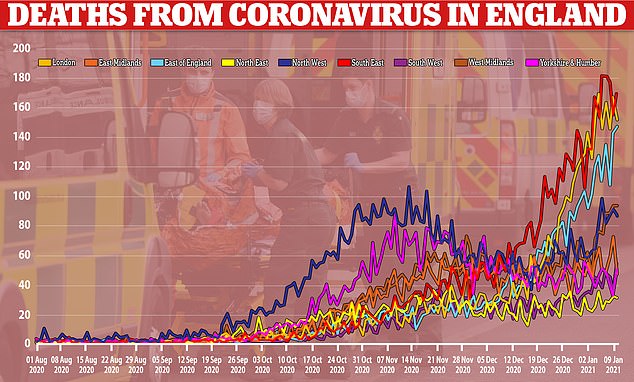
Public Health England data shows the biggest fall in the Covid-19 infection rate was in Havering – which was at the epicentre of the capital’s outbreak in early December.
Figures show infections in the East London borough plummeted by 40 per cent from 1,319 to 792 cases per 100,000 residents by January 12, the latest date for which data is available.
Infections also nosedived by a third in four other local authorities in the city – Redbridge, Bexley, Bromley and Kingston upon Thames – in another sign the second wave was running out of steam.
The infection rate has also dropped below England’s average of 538 per 100,000 in three areas – Kingston upon Thames, Westminster and Richmond upon Thames.
Official data suggests London hit its infection peak in the first week of January, when the seven-day rolling average was at 1,058 per 100,000. But since then it has plummeted to a low of 810 per 100,000 by January 12.
There is a delay between becoming infected with coronavirus, developing symptoms and testing positive, meaning it may not be clear how many people caught the virus on a certain day until a week later.
Despite the positive trend, however, many boroughs are still recording very high levels of infection.
Three of them – Barking and Dagenham, Newham and Ealing – still have rates over 1,000 cases per 100,000 people, almost double the national average. Four others – Brent, Hounslow, Redbridge and Croydon – are also teetering on the 1,000 per 100,000 mark.
Covid-19 hospitalisations in London have also peaked, in another sign draconian measures to curb the spread of the virus are finally bearing fruit.
Separate data from the Department of Health shows they dropped seven per cent in the seven days to January 11 compared to the same time last week, from 861 admissions a day to 802. For comparison, they had surged by 30 per cent the week before from 660 a day.
But Covid-19 admissions in the capital are still running dangerously very high, with NHS bosses warning hospitals bosses warning they could be overwhelmed by the influx of patients.
In yet another promising sign the city’s second wave is running out of steamand Tier Four stifled the spread of the virus and its mutant variant, its Covid-19 fatalities have also started to plateau.
They leapt by 66 per cent in the week to December 27, after spiralling by 38 fatalities a day from almost 58 to 94 by the end of the week. And they rocketed 50 per cent the following week, jumping by 46 to 140 on January 3.
But in the latest seven-day spell they rose by a quarter of the previous rate, ticking up by 17 deaths to just over 157 a day. Experts say it is possible deaths from the virus could peak in the coming days and start to drop.
There is a lag of around a week between a Covid-19 death happening and it being reported in the Government’s figures, which means it only becomes clear how many people died from the virus on a certain day up to a week later.
Deaths occurring in hospital are recorded more quickly on the figures, experts say, but it can take two weeks to get deaths from the virus at home into the numbers.
The capital’s slowdown has mirrored the drop in the number of people being admitted to the capital’s hospitals suffering symptoms of the virus – which dropped by five per cent in the week to January 10 from 845 admissions per day to 810.
And Covid-19 cases have also declined 25 per cent in a week, plummeting from 12,990 on average on January 3 to 9,750 a day by January 10.
TURNING THE TIDE: The above map shows coronavirus cases in London on January 5 (left) and a week later on January 12 (right) the latest date for which data is available
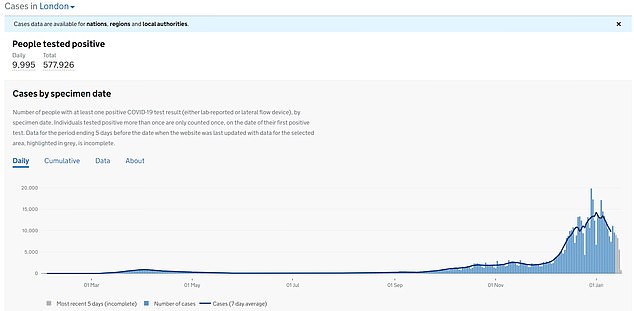
PEAKED: Cases have also started to dip markedly in the capital from January 1. The drop shows Tier 4 was enough to curb the spread of the mutant variant of the virus, experts have said, because it began before lockdown came into force
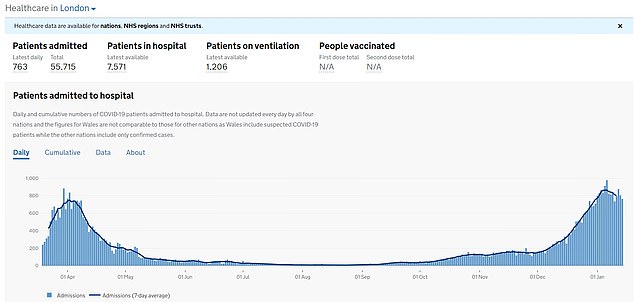
PEAKED: Hospitalisations with the virus have also peaked in the capital, in a sure sign that deaths will also begin to fall in the coming days – and possibly as early as this week
Professor Paul Hunter, a virologist at the University of East Anglia, said it was clear Tier Four was ‘probably sufficient’ to start bringing down infections, and with them hospitalisations and deaths.
‘There’s actually very little difference between from when Tier Four was in place because schools were closed anyway because of the holidays, and have now been closed by the national lockdown.’
But he added it would be advisable not to ‘read too much’ into deaths data at present because there can be a more than two week delay between someone dying from the virus and the fatality being registered.
‘For example, if one of my patients, back when I was working in a clinic, died I would sign the medical causes of death, which would typically be picked up within a day or two, and then they would have two weeks to notify that death.
‘So some of these deaths are being recorded and getting into the statistics quite quickly because they are happening in hospital but some (like those happening in the community) are taking a while to make it into the figures.’
He added he would be ‘very surprised’ if deaths didn’t also start to drop in the South East by the end of this week, because the number of infections and hospitalisations both appear to have already peaked in the region.
Professor Lawrence Young, a virologist at Warwick Medical School, told MailOnline the figures show it ‘looks like Tier Four was having some effect – which will be reinforced by the current lockdown’.
‘Aside from deaths, coronavirus cases are already falling in every London borough,’ he said, suggesting the figures also show the toughest tier was driving down transmission before the national shutdown.
‘Falls in the infection rate of up to 30 per cent have been seen in some areas over the past week.’
But he added it was likely ministers hit the panic button and imposed a national lockdown because of the ‘general confusion and complacency’ that he said was brought about by the tier system.
‘I think that the unevenness of the tier system across the country along with general confusion and complacency against a backdrop of rising case numbers and deaths led the Government to impose the current lockdown,’ he added.
Covid-19 hospitalisations in the capital have also peaked, in another sign efforts to curb the spread of the virus are paying off.
Data on the situation across England reveals hospitalisations have now either peaked or are flatlining in every region except the South West.
But it is possible that in areas where it has plateaued they are still rising – although at a far slower rate.
It comes amid fears London and Suffolk could lose out in the Covid vaccinations postcode lottery as millions of over-70s are offered jabs from today but only in areas where all the over-80s have already received their first dose.
Another five million people are being invited to receive their first dose, with some in Whitehall suggesting the roll out is going so well that the wider population could be covered by June rather than September.
In the capital vaccinations have been trailing behind the rest of the country, with Tory MPs voicing alarm that the supplies were being based on take-up of the flu vaccine last winter.
Health Secretary Matt Hancock said yesterday that the nation was ‘nearly on the home straight’ as 50 per cent of all over-80s in England have been vaccinated.
Some 140 a minute are receiving a jab, putting Britain on course to vaccinate all adults by early autumn. However, one coronavirus patient is being admitted to hospital every 30 seconds.
NHS data shows the North East and Yorkshire made most headway in the first month of vaccinations, reaching 44 per cent of all over-80s. This was almost twice as fast as in the East of England and London, which only managed to immunise 27.9 per cent and 29.5 per cent of its most elderly residents, respectively.
The capital was downgraded to a ‘major incident’ on January 8 by the mayor Sadiq Khan, meaning its hospitals are at serious risk of being overwhelmed by spiralling admissions.
‘The situation in London is now critical with the spread of the virus out of control,’ the mayor said.
‘The number of cases in London has increased rapidly with more than a third more patients being treated in our hospitals now compared to the peak of the pandemic last April.
‘Our heroic doctors, nurses and NHS staff are doing an amazing job, but with cases rising so rapidly, our hospitals are at risk of being overwhelmed. The stark reality is that we will run out of beds for patients in the next couple of weeks unless the spread of the virus slows down drastically.’
Police blasted a ‘small selfish minority’ ignoring the rules at the time and promised to come down hard on transgressors who are refusing to stop partying despite the highly transmissible pathogen being rife.
Deputy Assistant Commissioner Matt Twist said: ‘I know Londoners will be shocked that officers are still dealing with a small selfish minority who think the rules don’t apply to them by holding house parties, large warehouse raves or other gatherings. These are creating breeding grounds for the much more transmissible variant.’
Professor Kevin Fenton, Public Health England’s regional director for London, said: ‘This is the biggest threat our city has faced in this pandemic to date.’
Mr Khan said that over three days to January 8 alone the NHS had announced 477 deaths in London hospitals following a positive test for Covid-19.
In a letter to Boris Johnson he demanded churches and other places of worship be closed and for face masks to be worn routinely outside of the home, including in supermarket queues and other places outside that may be crowded.
He also called for more financial support for Londoners who need to self-isolate and are unable to work, and for daily vaccination data.
Tory MPs demand a route out of lockdown after infections drop AGAIN with 37,535 more Covid cases, 599 new deaths and 4million vaccinations
By James Tapsfield, Political Editor for MailOnline
Boris Johnson defied fresh demands from Tory MPs for a ‘road map’ out of lockdown as coronavirus infections tumbled again.
The PM is under pressure to say how and when the brutal restrictions in England will ease after the UK recorded another 37,535 cases – down a fifth from last Monday.
Although deaths rose again to 599 there are increasing signs that the curve is flattening, as it lags weeks behind the new infections.
Conservatives this evening underlined calls from former chief whip Mark Harper, who heads the CRG group of lockdown-sceptics, to say what will happen when the government has vaccinated the four most vulnerable groups – which is meant to happen by mid-February. The number of people receiving their first jab topped four million today.
The deputy chairman of the group, Steve Baker, said: ‘We locked down the country and shut down our schools on the basis of a forecast, so why can’t we open it up on the basis of one too? It is not sustainable to leave the public and British businesses languishing any longer.
‘Businesses and individuals desperately need hope and the opportunity to plan our recovery, that’s why we need to know our road to recovery as soon as possible.’
Another Tory backbencher told MailOnline the government should lay out its plans even if it is like ‘snakes and ladders’ and the arrangements later have to change.
However, Mr Johnson poured cold water on the idea this afternoon, insisting that it will not be possible to set out the route for unwinding restrictions until February 15.
Touring the Oxford Biomedica vaccine plant, the PM also warned when the loosening does come it will not be an ‘open sesame’ moment.
‘I understand completely that people want to get back to normal as fast as we possibly can. It does depend on things going well,’ he said.
‘It depends on the vaccination programme going well, it depends on there being no new variants that throw our plans out and we have to mitigate against, and it depends on everybody, all of us, remembering that we’re not out of the woods yet.’
He said: ‘We’re going as fast as we can but I stress we can do everything we can to open up but when we come to February 15, and the moment when we have to take stock of what we’ve achieved, that’s the time to look at where the virus is, the extent of the infection and the success that we’ve had.
‘It’s only really then that we can talk about the way ahead and what steps we can take to relax.
‘I’m afraid I’ve got to warn people it will be gradual, you can’t just open up in a great open sesame, in a great bang, because I’m afraid the situation is still pretty precarious.’
The wrangling came as ministers face a backlash over a vaccination ‘postcode lottery’, with millions of 70-somethings being offered a jab — but only in areas where the ‘majority’ of over-80s have had it already.
Nearly 5million people aged between 70 and 80 are being invited to receive their first dose, with some in Whitehall suggesting the rollout is going so well that the wider adult population could be covered by June rather than September.
However, vaccines minister Nadhim Zahawi said people in their 70s will only be offered jabs in areas where the ‘majority’ of over-80s have already had their first shot. That could mean people in areas such as London and Suffolk, where progress has been slower, will have to wait longer.
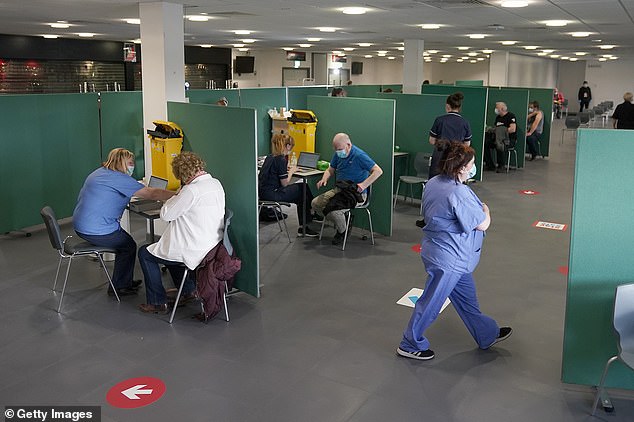
NHS staff administer the AstraZeneca coronavirus vaccine at the Totally Wicked Stadium, home of St Helens rugby club, one of the new mass vaccination centres opened today
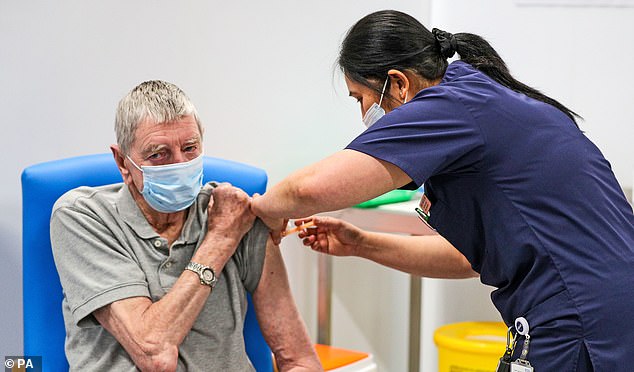
John Mason, 82, receiving a Covid-19 vaccination from nurse Anie Santillan in the crypt of Blackburn Cathedral today
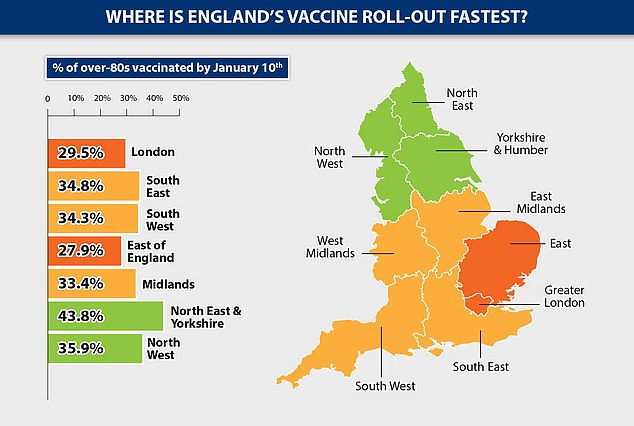
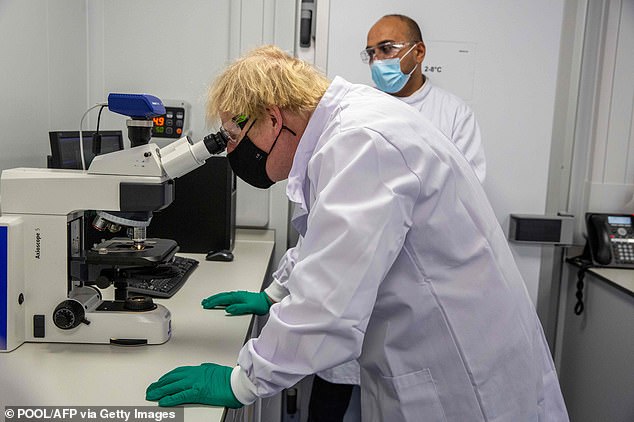
Boris Johnson was shown the vaccine quality control systems on a visit to Oxford Biomedica in Oxfordshire today
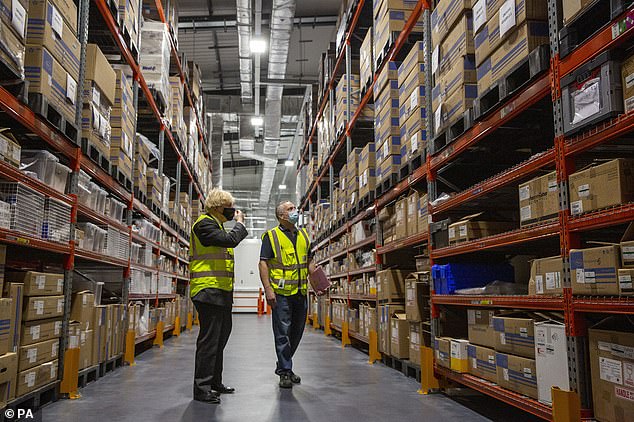
The Prime Minister toured a warehouse at the vaccine manufacturing facility in Oxfordshire today
On another turbulent day of developments in the coronavirus crisis:
Writing in the Sunday Telegraph yesterday, Mr Harper set out CRG demands for the PM to publish a draft plan this week setting out how curbs will be lifted.
The Government is due to conduct its first formal review of lockdown on February 15 and Mr Harper said ministers could at that point firm up the proposals ahead of an easing of rules in March.
He said: ‘The top four at-risk groups, which the Government aims to have given a first dose by Feb 15, will have got the maximum immunity from that within three weeks – by March 8.
‘That has got to be the point at which we start to lift restrictions in a way proportionate to the reduction of risk.’
Mr Harper said that ‘nobody is expecting nightclub doors to be flung open on March 8’ because it is ‘obvious that not every restriction can be lifted straight away’.
He pointed to Mr Johnson’s previous suggestion that there will be a ‘gradual unwrapping’ of lockdown and said he agreed that will be the best approach to take.
‘People need hope and businesses need a plan in order to survive, especially those in the hospitality, tourism and leisure sectors,’ he said.
‘That’s why this week, we need a draft plan for the progressive lifting of restrictions from March 8 so that the public, businesses and scientists can use it as the basis for a sensible debate, as the Prime Minister suggested on Friday.
‘That will allow a definitive plan to be published ahead of Feb 15.’
Mr Baker said tonight: ‘Just like the disease, lockdowns and restrictions cause immense harm – to people’s health, their livelihoods and to our children’s life chances. So it’s a relief to hear that once the top four groups have been vaccinated and immunised by 8 March at the latest, Government will start easing the restrictions.
‘It’s important that we lift restrictions in a way that is proportionate and safe. The Health Secretary has told us that the vast majority of hospitalisations and death caused by Covid will be protected against by 8 March, so this clearly implies that we should be removing the vast majority of restrictions.
‘It is crucial that our response to Covid is proportionate at all times to the harm the disease is capable of causing – which by 8 March should, thankfully, be hugely diminished if we hit the 15 February vaccination rollout target.’
The government is facing concerns it has moved too fast to roll out vaccines for over-70s, with large disparities between how many have been administered in different parts of the country.
London has given the lowest number in England so far, with a total of 417,225 doses between December 8 and January 17, including 367,209 first doses and 50,016 second doses.
This compares to 746,487 total jabs in the Midlands, 681,317 in the North East and Yorkshire, 541,145 in the North West, 652,350 in the South East, 461,792 in the South West and 424,135 in the East of England.
The eligibility is being expanded despite vaccines not yet having been distributed to all care homes. Most residents and carers have already had their first shot in Newcastle, but in rural Suffolk the programme is struggling to speed up.
The PM defended the shift this afternoon, insisting that while the four most vulnerable groups remained the ‘top priority’ it was right to widen the scheme ‘as more vaccine comes on stream’. Asked if he was concerned about a postcode lottery, Mr Johnson said: ‘I think actually the whole of the UK is going very well. And, overall, the pace of the rollout is very encouraging.’
Cabinet minister Therese Coffey voiced frustration today, saying ‘something isn’t right’ and it was ‘distressing and annoying’ that individuals in their 70s were being offered jabs ahead of the more elderly.
‘Vaccinations started well in Suffolk Coastal in the last few days, but something isn’t quite right as in some places, patients aged 70+ are being contacted for vaccination ahead of 80+/90+ year olds,’ she tweeted.
Ms Coffey later said that she had been assured ‘letters and messages will be going out today’ to all over-80s who had not already been contacted.
Letters are being sent out in England inviting the next two priority groups for vaccinations. That includes 4.6million in their 70s plus another one million classed as ‘clinically extremely vulnerable’ because they have conditions affecting the immune system, certain cancers or are organ transplant recipients.
In London vaccinations have been trailing behind the rest of the country, with Tory MPs voicing alarm that the supplies are being based on take-up of the flu vaccine last winter, which was low in the capital.
Downing Street insists the supplies are being ‘distributed equally’.
Some 140 people a minute are receiving a jab, putting Britain on course to vaccinate all adults by early autumn, if not before. However, one coronavirus patient is being admitted to hospital every 30 seconds.
The Government last night announced that the first phase of the vaccine programme has made enough progress that those in their 70s and on the shielding list will be called up to get their jabs from today.
But in some places medics still haven’t got through to the over-90s, who are in the top priority group for the Covid vaccines. Matt Hancock last week revealed GPs leading Britain’s great vaccination drive were forced to pause jabs to allow other parts of the country to catch up.
Newcastle’s care homes saw all their residents get vaccinated against Covid by seven medical teams who made their way through the city in just two weeks.
Care home residents are top of the Government’s priority list for vaccination because they face such a high chance of dying if they catch Covid-19.
Ministers pledged to get jabs to all of them – there are around 400,000 people living in homes across the UK – by the end of January.
The roll-out could not start immediately because the first vaccine to be approved, Pfizer’s, had to be kept in specialist freezers so couldn’t be transported in batches smaller than 1,000 to begin with.
But since the approval of Oxford and AstraZeneca’s jab, which can be kept out of the fridge for almost an entire working day, the care home programme has sped up.
Leader of Newcastle City Council, Nick Forbes, said: ‘In less than two weeks we have protected the most vulnerable people in our communities, providing the residents and their families with a sense of reassurance and hope they have longed for.
‘It is also relief for care home staff who have given so much during this pandemic, prioritising the health and care of the residents they work with.’
Public Health England data shows that the North East & Yorkshire – the region containing Newcastle – was furthest ahead with its vaccine programme by January 10.
This is the most recent data available and local figures are not yet available for areas smaller than regions.
It shows that the North East and Yorkshire had vaccinated 370,694 people by January 10.
Elderly people have been the priority since the vaccine programme started and data published by Public Health England shows exactly how many of them have been vaccinated.
PHE figures show that 43.8 per cent of over-80s in the North East & Yorkshire had received a Covid vaccine by January 10, compared to 27.9 per cent in the East of England.
In London the figure was 29.5 per cent, in the Midlands 33.4 per cent, in the South West 34.3 per cent, in the South East 34.8 per cent and in the North West 35.9 per cent.
Mr Johnson last week told MPs: ‘There are parts of the country where they have done incredibly well in, for instance, vaccinating the over-80s.
‘We are well over 50 per cent now in the North East and Yorkshire; less good in some other parts of the country.’
It is not clear whether some regions are vaccinating fewer people because they can’t get enough supplies or because they aren’t rolling them out quick enough.
Hailing the vaccine expansion today, Mr Johnson said it ‘marks a significant milestone as we offer vaccinations to millions more people who are most at risk from Covid-19’.
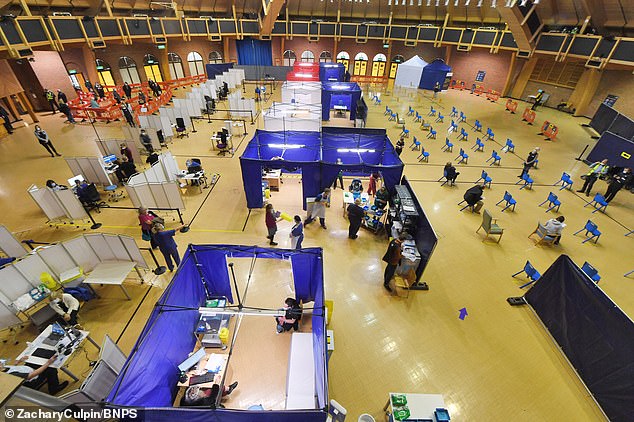
The vaccination centre in Bournemouth officially opened today and is expected to give jabs to more than 9,000 a month
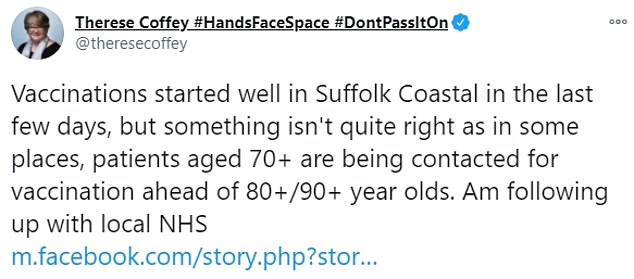
Cabinet minister Therese Coffey complained this morning that in her constituency some individuals in their 70s were being offered jabs ahead of the more elderly
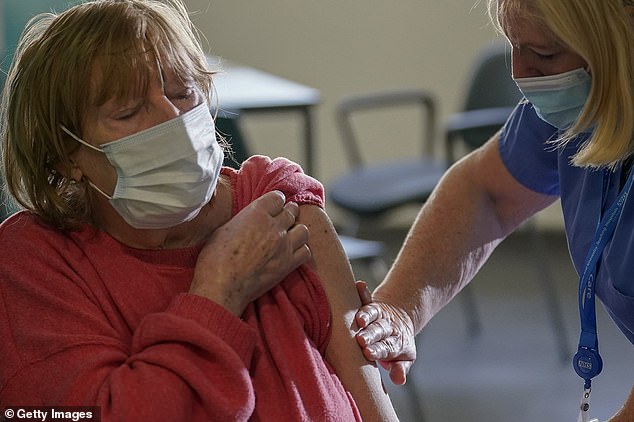
NHS staff administering the vaccine in St Helens today as the drive to innoculate the population steps up another gear


Vaccines minister Nadhim Zahawi (left) was bullish about the September target for covering all adults in a round of interviews this morning. NHS England medical director Stephen Powis (right) today warned that vaccines will not have an impact on the death rate until ‘well into’ February
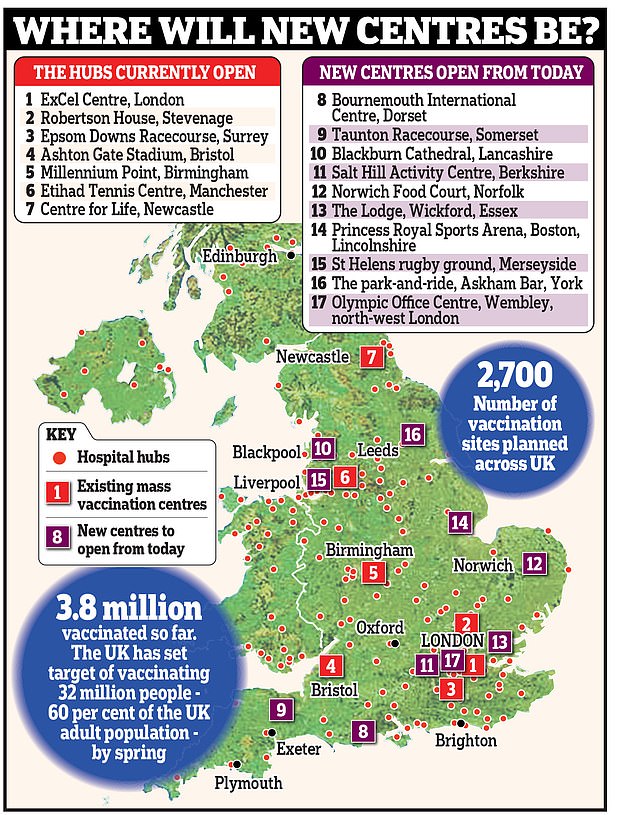
‘We have a long way to go and there will be challenges ahead – but together we are making huge progress in our fight against this virus,’ he said.
There are claims swirling that Mr Johnson wants all adults to get an initial jab by June. And Mr Zahawi backed the target to offer a first jab to everyone by September as ‘achievable’.
However, he fuelled questions about the way in which people are getting access by confirming that over-70s are currently being offered first jabs in areas only where ‘the majority’ of over-80s have had their first shot. The speed of the process has varied widely in different areas.
‘Anyone who is over 80 watching us this morning should not worry because we are making sure that those areas have vaccinated the majority of their over-80s,’ Mr Zahawi told the BBC.
‘And in some areas they’ve got to 90 per cent of their over-80s, that’s where the letters are going out for the over-70s to invite them for their vaccinations.’
Downing Street said those aged over 70 would start to be offered vaccines in areas where the ‘majority’ of those in the older age category and higher up the priority list had already received their first jab – but refused to say what that meant.
A spokesman said: ‘From today, those aged 70 and over will begin receiving invitation for vaccination, and it will be for them to book an appointment or come forward.
‘Depending on where they are, the timing will be slightly different but the important point is that this allows areas that have already vaccinated a majority of those over 80, care home residents, frontline NHS and care home staff to keep the momentum up and to start giving it to further-at-risk people.’
Asked whether those in their 70s could expect to start receiving their vaccination this week, the spokesman said the jabs would start ‘shortly’.
The PM’s spokesman also insisted supplies were being ‘distributed equally’ across the country.
‘In some areas where they have already vaccinated the majority of those four high-risk groups, we want to ensure we maintain momentum and continue to rollout the vaccine to more and more people who are at higher clinical risk – that’s why we sent out the letter to the over-70s,’ the spokesman said.
‘The Prime Minister has stated clearly that we will ensure that everybody in the first four priority groups will receive a vaccination by February 15 and we’ve also said that care home residents will all have received it by the end of the month.’
But Work and Pensions Secretary Ms Coffey was among those expressing alarm at the situation, although she later said she had been reassured.
‘I know it is both distressing and annoying when people hear that other cohorts of a lower priority (according to the JCVI) are being vaccinated ahead of our oldest and most vulnerable. On that point, every care home resident will be vaccinated by next Sunday,’ she posted on Facebook.
‘I am already in regular contact with the NHS and Ministers but will be following up with the local NHS to work out what is going on regarding contacting 80+ population (main route is by text and/or letter) and will be pressing for some local communication.’< /p>
Touring the Oxford Biomedica vaccine plant today, Mr Johnson appeared to dismiss demands from Tory MPs for an early ‘road map’ to show how lockdown will be eased.
And he warned when the loosening does come it will not be an ‘open sesame’ moment.
The PM told reporters: ‘I understand completely that people want to get back to normal as fast as we possibly can. It does depend on things going well.
‘It depends on the vaccination programme going well, it depends on there being no new variants that throw our plans out and we have to mitigate against, and it depends on everybody, all of us, remembering that we’re not out of the woods yet.’
He said: ‘We’re going as fast as we can but I stress we can do everything we can to open up but when we come to February 15, and the moment when we have to take stock of what we’ve achieved, that’s the time to look at where the virus is, the extent of the infection and the success that we’ve had.
‘It’s only really then that we can talk about the way ahead and what steps we can take to relax.
‘I’m afraid I’ve got to warn people it will be gradual, you can’t just open up in a great open sesame, in a great bang, because I’m afraid the situation is still pretty precarious.’
Mr Zahawi laid out the timetable for easing the lockdown, although he warned there were ‘caveats’ about whether it could happen in early March.
He told BBC Breakfast: ‘If we take the mid-February target, two weeks after that you get your protection, pretty much, for the Pfizer/BioNTech, three weeks for the Oxford/AstraZeneca, you are protected.
‘One of the things we don’t know yet, and the deputy chief medical officer Jonathan Van-Tam is on record as saying ‘look give me a couple of months and I’ll tell you’, is the impact of the vaccine on transmission rates ie on infecting people.
‘So there are a number of caveats that stand in the way of us reopening the economy.
‘It will be gradually, it will be probably through the tiered system but you’re looking at that sort of period, two to three weeks after the middle of February, after we’ve protected the top four cohorts.’
He said there should be ‘very clear evidence’ by the second week in March that there had been a ‘break in the correlation between infection rates and hospitalisation and obviously death’.
‘There is some really good early data from Israel, where they have vaccinated 20 per cent of the over-60s and they are beginning to see, two weeks later, a marked reduction in the serious illness and death in that same cohort.
‘So, two weeks after mid-February, we should be seeing a marked reduction in death and of course serious illness,’ he said.
Mr Zahawi said 24-hour vaccinations will be piloted in London hospitals by the end of January – but he played down the usefulness of the idea in the first phase.
He told Sky News: ‘We are going to pilot the 24-hour vaccination, the NHS is going to pilot that in hospitals in London and we will look at how we expand that.’
Pressed for when the pilots will start, he said: ‘By the end of January, absolutely.’
But he said 8am-8pm vaccination ‘works much more conveniently for those who are over 80 and then as you move down the age groups it becomes much more convenient for people to go late at night and in the early hours’.
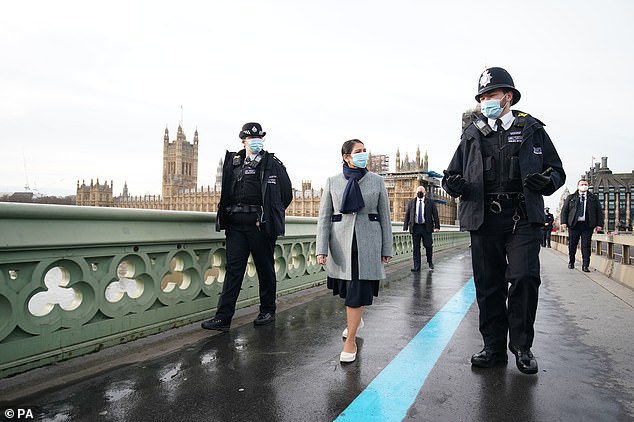
Home Secretary Priti Patel today vowed tougher enforcement on lockdown-sceptic protests as she chatted to police officers in Westminster
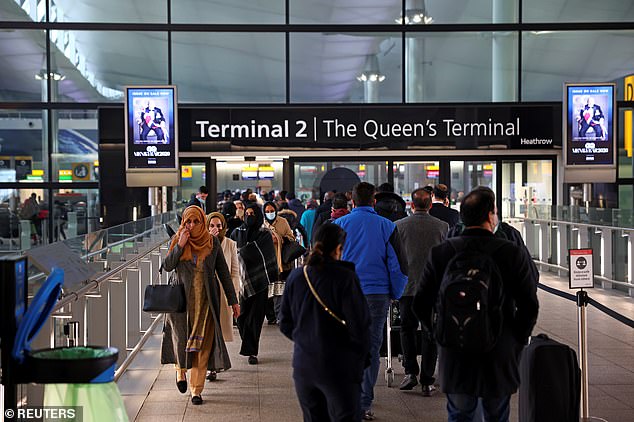
Several passengers have been refused permission to fly to Britain from the US today after being told their negative Covid results were ‘not sufficient’. Pictured, Heathrow Airport
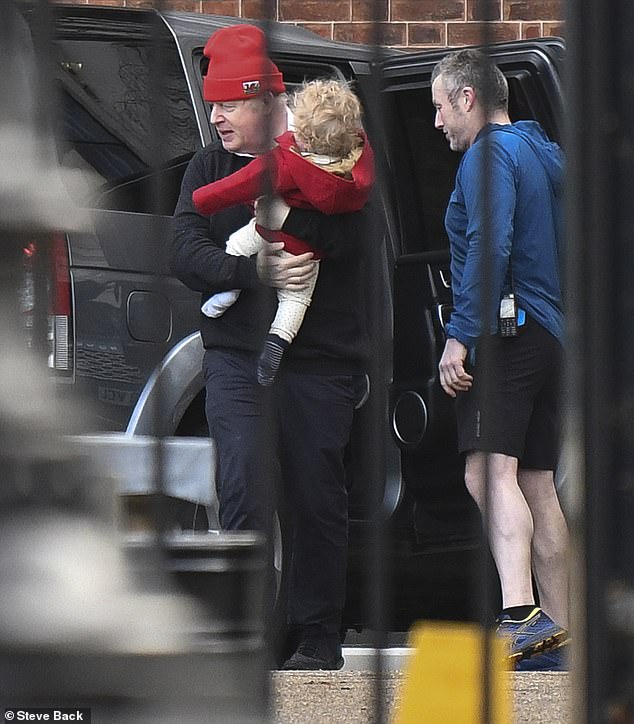
Boris Johnson, pictured with his son Wilfred on Sunday, has promised the first four priority groups will all have received the jab by the middle of February
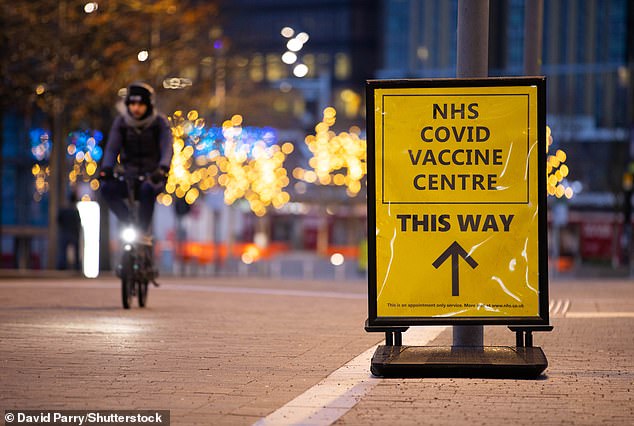
The new mass vaccination hub that has opened in the Olympic Office Centre in Wembley, London today
Priti Patel vows tougher action on lockdown-sceptic protests
Meanwhile, Welsh First Minister Mark Drakeford has defended the slower rollout of the vaccination programme in Wales – saying the Pfizer vaccine could not be used all at once.
The Welsh Government has faced criticism in the past week for vaccinating fewer people in proportion to its population than the other home nations.
Statistically, Wales is behind the other nations of the UK in delivering the first dose of the vaccine per 100,000.
As of last week, 3,215 had received it in Wales, compared to 3,514 in Scotland, 4,005 in England and 4,828 in Northern Ireland.
Mr Drakeford dismissed the statistics as ‘very marginal differences’, and went on to explain that supplies of the Pfizer vaccine had to last until the beginning of February and would not be used all at once.
‘There will be no point and certainly it will be logistically very damaging to try to use all of that in the first week and then to have all our vaccinators standing around with nothing to do with for another month,’ he told BBC Radio 4’s Today programme.
‘The sensible thing to do is to use the vaccine you’ve got over the period that you’ve got it for so that your system can absorb it, they can go on working, that you don’t have people standing around with nothing to do.
Mr Raab pledged yesterday that every over-18 will be offered a first jab by September – if not earlier.
And he said he was hopeful some lockdown restrictions could start to be lifted from March.
Ten new mass vaccination hubs will open today, including Blackburn Cathedral and Taunton Racecourse.
Ministers said the priority this week will still be to vaccinate the top two priority groups, made up of care home residents and staff, the over-80s, and NHS workers.
More than 3.8million have received their first vaccine dose so far. But NHS sites which have spare capacity will be allowed to offer jabs to those aged over 70 and those who are ‘clinically extremely vulnerable’.
Boris Johnson has promised the first four priority groups will all have received the jab by the middle of February.
The PM said: ‘Today is a significant milestone in our vaccination programme as we open it up to millions more who are most at risk from Covid-19. We are now delivering the vaccine at a rate of 140 jabs a minute and I want to thank everyone involved in this national effort.
‘We have a long way to go and there will doubtless be challenges ahead – but by working together we are making huge progress in our fight against this virus.’
Mr Hancock added: ‘Now that more than half of all over-80s have had their jab, we can begin vaccinating the next most vulnerable groups.
‘Where an area has already reached the vast majority of groups one and two, they can now start opening up the programme to groups three and four.
‘We are working day and night to make sure everyone who is 70 and over, our health and social care workers and the clinically extremely vulnerable are offered the vaccine by the middle of February and our NHS heroes are making huge strides in making this happen.’ Mr Raab said yesterday it would be ‘great’ if the rollout could be faster amid reports that the target of offering everyone in the UK the jab could be met by June, but said the Government was working to the early autumn target.
‘Our target is by September to have offered all the adult population a first dose. If we can do it faster than that, great, but that’s the roadmap,’ he told Sky News’ Sophy Ridge on Sunday.
Mr Raab said the Government hoped 88 per cent of those most at risk of dying from coronavirus would receive their first jab by the middle of February, with 99 per cent of those at greatest risk protected by the early spring.
He suggested lockdown restrictions could then be eased – with a possible return to the tiered system. ‘I think it is fair to say it won’t be a big bang, if you like, it will be done phased, possibly back through the tiered approach,’ he told BBC1’s Andrew Marr Show.
Asked if vaccine supplies are sufficient for someone to get their second dose within 12 weeks, he said ‘we ought to’ be able to deliver.
Sir Simon Stevens said staff were jabbing ‘four times faster’ than people are newly catching the virus.
He also predicted lockdown could be eased ‘gradually’ around spring and summer time. However, he said this would depend on the effect of new variants of coronavirus.
A new strain found in the UK that is more transmissible than previous types is rapidly spreading across the country, and variants found in Brazil and South Africa are also being viewed with concern by virologists in case they are more resistant to vaccines.
Has London beaten the second wave of Covid? Dramatic map shows how infections are falling in EVERY borough, hospital cases continue to drop and deaths began falling last week
Luke Andrews and Connor Boyd Assistant Health Editor and Jack Wright for MailOnline
London’s devastating winter wave of coronavirus appears to have passed its peak, as official data shows infections were falling in all 32 boroughs last week and deaths and hospital admissions have begun to plateau.
Scientists say the promising figures are proof that tough Tier Four curbs were driving down the spread of the super-infectious Kent strain of the virus before the national lockdown.
Public Health England figures show cases fell in every borough of the capital over the seven days to January 12, with the London-wide infection rate plummeting by more than a quarter.
The trends in data earlier this month could not have been triggered by the national lockdown that came into force on January 4 because it takes about three weeks for drac
onian curbs to drive down infections and cases. It suggests Tier Four was turning the tide on the capital’s second wave, but experts say the tiered approach was bolstered massively by the fact schools were closed for the festive break.
It suggests Tier Four was turning the tide on the capital’s second wave, but experts say the tiered approach was bolstered massively by the fact schools were closed for the festive break.
Both regions are also recording a slowdown in cases and hospitalisations, but deaths are only plateauing in the East of England. Scientists say they expect deaths to also flatline in the South East by the end of this week.
In another sign Britain has turned the tide on the second wave Covid-19 hospitalisations are now only surging in the South West, which enjoyed the fewest curbs on daily life under the tiered system.
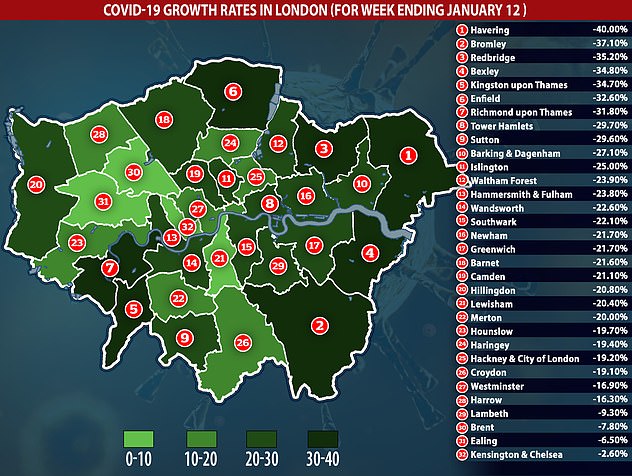
Department of Health figures show how weekly infection rates — the number of positive tests per every 100,000 people — changed in the seven-day spell ending January 12, compared to January 5
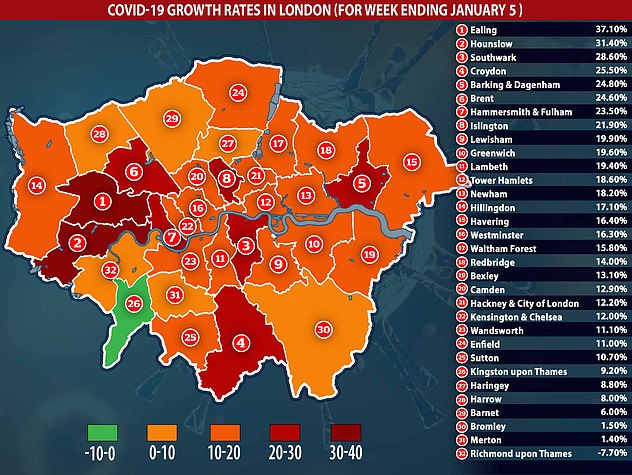
Department of Health figures show how weekly infection rates — the number of positive tests per every 100,000 people — changed in the seven-day spell ending January 5, compared to December 29
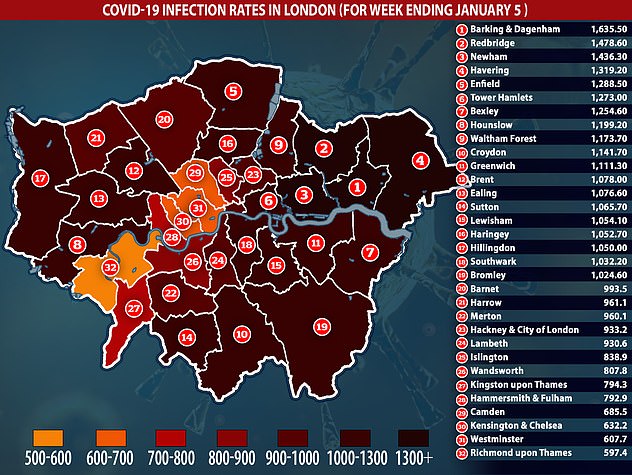
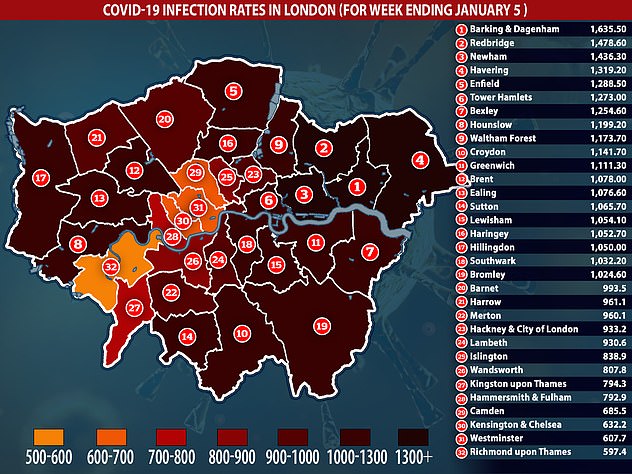
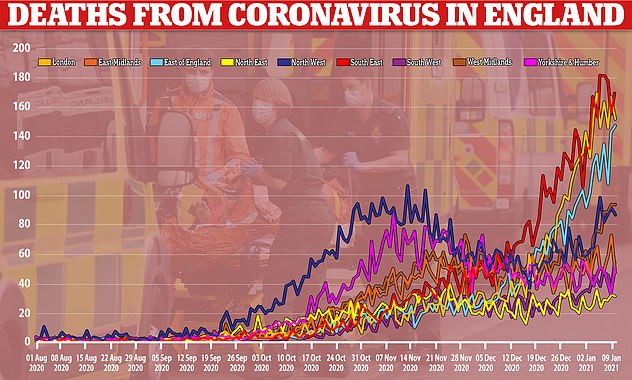
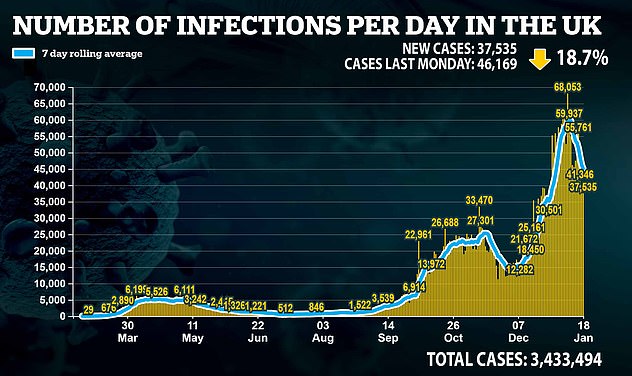
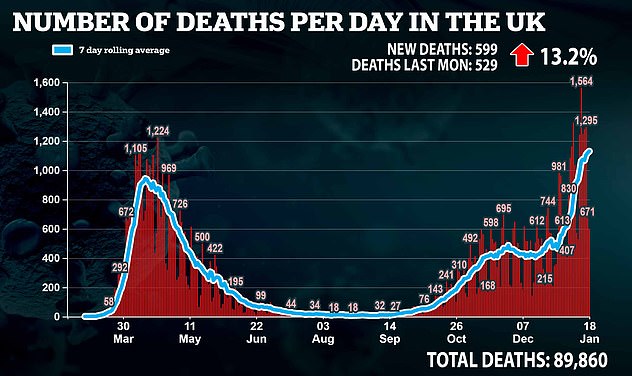
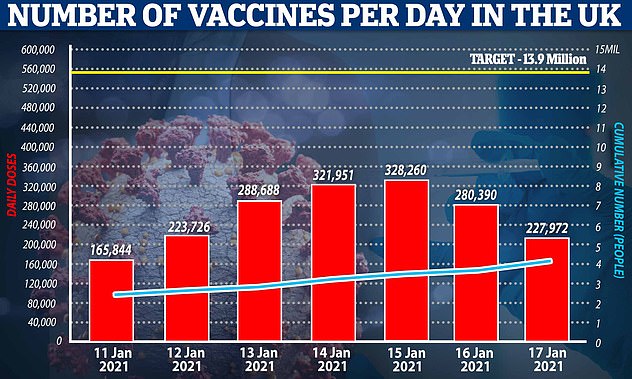
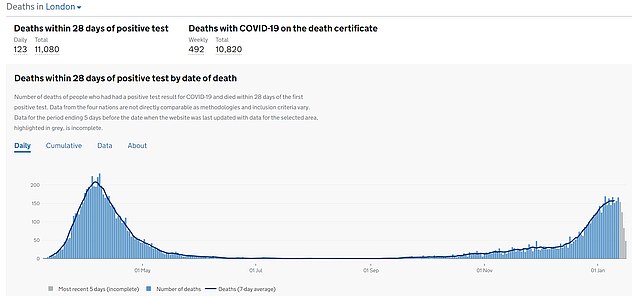
SLOWING: Covid-19 deaths appear to be plateauing in the capital after they rose by 12 per cent in the seven days to January 10 to 157 a day, the latest date where data is available, but surged by 50 per cent the week before
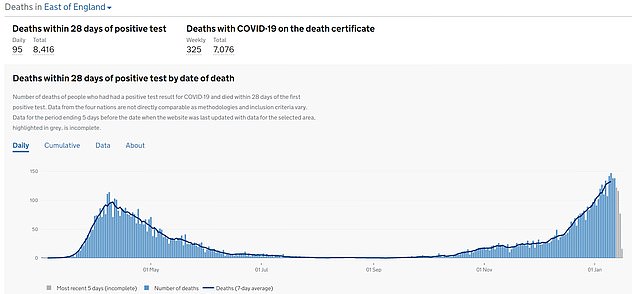
SLOWING: The East of England – which was first into Tier 4 alongside London – appears to be following the capital’s trend. It has also seen a levelling off in deaths after they rose 24 per cent last week to 133 a day, but 32 per cent the week before
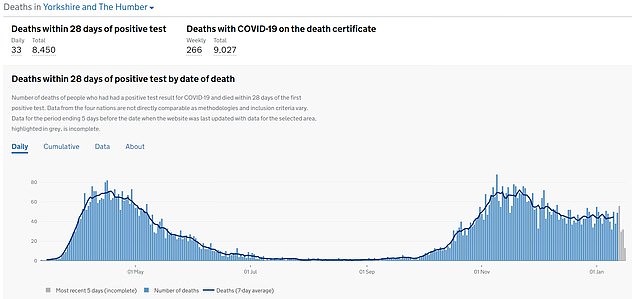
PEAKED?: Fatalities from the virus are level in Yorkshire and the Humber – which endured weeks of tougher measures under the old tier system. It appears they may now be dropping, after they declined three per cent in the week to January 10
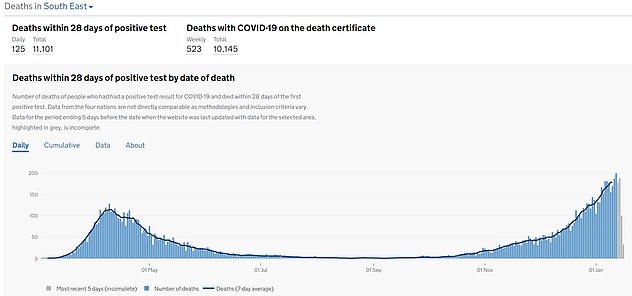
RISING: Covid-19 deaths are still spiralling in the South East where they rose by 24 per cent last week compared to 20 per cent the week before despite the region being among the first into Tier 4. But there are early signs they could be levelling off, experts say, who add they would be ‘very surprised’ if they didn’t drop by the end of this week
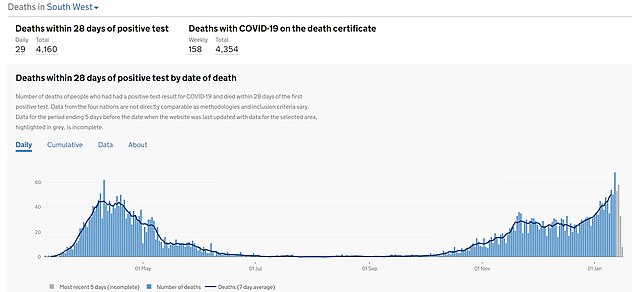
RISING: Covid-19 deaths are also still rising in the South West, where they surged by 36 per cent last week to 50 a day compared to a 26 per cent jump last week to 37 a day
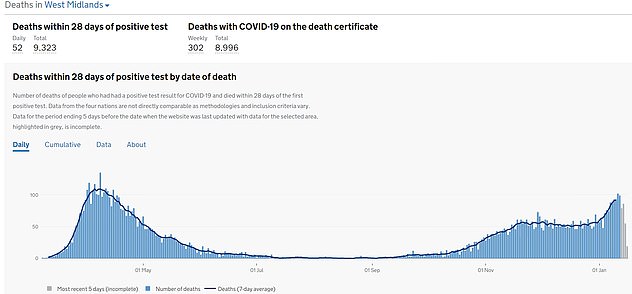
RISING: And in the West Midlands they were up by 44 per cent last week to 92 a day, compared to a 16 per cent rise the week before to 64 a day
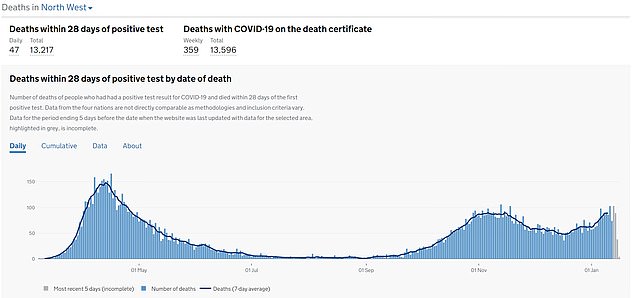
RISING: Deaths are also shifting upwards again in the North West. They rose by 29 per cent last week to 89 a day, compared to an 11 per cent rise the week before to 69 a day
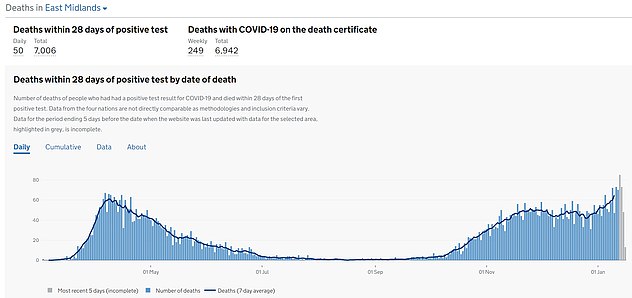

RISING: The East Midlands is also recording rising deaths. They surged by 24 per cent last week to 65 a day compared to by 20 per cent the week before to 52 a day
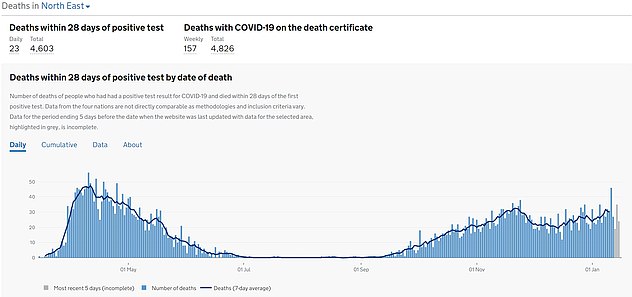
RISING: In the North East deaths are also heading in the wrong direction, jumping by 17 per cent last week to 30 a day compared to falling two per cent the week before to 26 a day
Public Health England data shows the biggest fall in the Covid-19 infection rate was in Havering – which was at the epicentre of the capital’s outbreak in early December.
Figures show infections in the East London borough plummeted by 40 per cent from 1,319 to 792 cases per 100,000 residents by January 12, the latest date for which data is available.
Infections also nosedived by a third in four other local authorities in the city – Redbridge, Bexley, Bromley and Kingston upon Thames – in another sign the second wave was running out of steam.
The infection rate has also dropped below England’s average of 538 per 100,000 in three areas – Kingston upon Thames, Westminster and Richmond upon Thames.
Official data suggests London hit its infection peak in the first week of January, when the seven-day rolling average was at 1,058 per 100,000. But since then it has plummeted to a low of 810 per 100,000 by January 12.
There is a delay between becoming infected with coronavirus, developing symptoms and testing positive, meaning it may not be clear how many people caught the virus on a certain day until a week later.
Despite the positive trend, however, many boroughs are still recording very high levels of infection.
Three of them – Barking and Dagenham, Newham and Ealing – still have rates over 1,000 cases per 100,000 people, almost double the national average. Four others – Brent, Hounslow, Redbridge and Croydon – are also teetering on the 1,000 per 100,000 mark.
Covid-19 hospitalisations in London have also peaked, in another sign draconian measures to curb the spread of the virus are finally bearing fruit.
Separate data from the Department of Health shows they dropped seven per cent in the seven days to January 11 compared to the same time last week, from 861 admissions a day to 802. For comparison, they had surged by 30 per cent the week before from 660 a day.
But Covid-19 admissions in the capital are still running dangerously very high, with NHS bosses warning hospitals bosses warning they could be overwhelmed by the influx of patients.
In yet another promising sign the city’s second wave is running out of steamand Tier Four stifled the spread of the virus and its mutant variant, its Covid-19 fatalities have also started to plateau.
They leapt by 66 per cent in the week to December 27, after spiralling by 38 fatalities a day from almost 58 to 94 by the end of the week. And they rocketed 50 per cent the following week, jumping by 46 to 140 on January 3.
But in the latest seven-day spell they rose by a quarter of the previous rate, ticking up by 17 deaths to just over 157 a day. Experts say it is possible deaths from the virus could peak in the coming days and start to drop.
There is a lag of around a week between a Covid-19 death happening and it being reported in the Government’s figures, which means it only becomes clear how many people died from the virus on a certain day up to a week later.
Deaths occurring in hospital are recorded more quickly on the figures, experts say, but it can take two weeks to get deaths from the virus at home into the numbers.
The capital’s slowdown has mirrored the drop in the number of people being admitted to the capital’s hospitals suffering symptoms of the virus – which dropped by five per cent in the week to January 10 from 845 admissions per day to 810.
And Covid-19 cases have also declined 25 per cent in a week, plummeting from 12,990 on average on January 3 to 9,750 a day by January 10.
TURNING THE TIDE: The above map shows coronavirus cases in London on January 5 (left) and a week later on January 12 (right) the latest date for which data is available
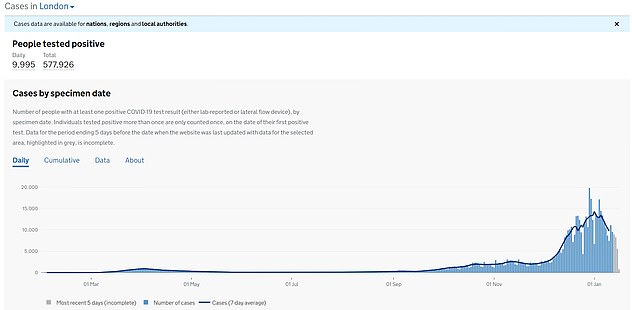
PEAKED: Cases have also started to dip markedly in the capital from January 1. The drop shows Tier 4 was enough to curb the spread of the mutant variant of the virus, experts have said, because it began before lockdown came into force
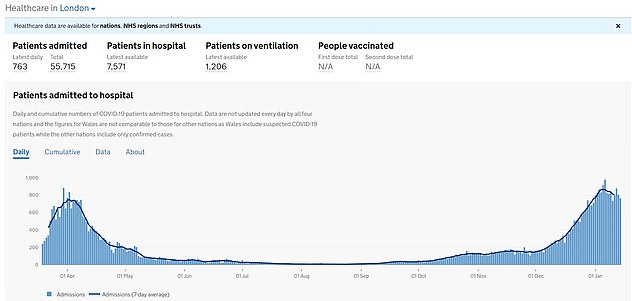
PEAKED: Hospitalisations with the virus have also peaked in the capital, in a sure sign that deaths will also begin to fall in the coming days – and possibly as early as this week
Professor Paul Hunter, a virologist at the University of East Anglia, said it was clear Tier Four was ‘probably sufficient’ to start bringing down infections, and with them hospitalisations and deaths.
‘There’s actually very little difference between from when Tier Four was in place because schools were closed anyway because of the holidays, and have now been closed by the national lockdown.’
But he added it would be advisable not to ‘read too much’ into deaths data at present because there can be a more than two week delay between someone dying from the virus and the fatality being registered.
‘For example, if one of my patients, back when I was working in a clinic, died I would sign the medical causes of death, which would typically be picked up within a day or two, and then they would have two weeks to notify that death.
‘So some of these deaths are being recorded and getting into the statistics quite quickly because they are happening in hospital but some (like those happening in the community) are taking a while to make it into the figures.’
He added he would be ‘very surprised’ if deaths didn’t also start to drop in the South East by the end of this week, because the number of infections and hospitalisations both appear to have already peaked in the region.
Professor Lawrence Young, a virologist at Warwick Medical School, told MailOnline the figures show it ‘looks like Tier Four was having some effect – which will be reinforced by the current lockdown’.
‘Aside from deaths, coronavirus cases are already falling in every London borough,’ he said, suggesting the figures also show the toughest tier was driving down transmission before the national shutdown.
‘Falls in the infection rate of up to 30 per cent have been seen in some areas over the past week.’
But he added it was likely ministers hit the panic button and imposed a national lockdown because of the ‘general confusion and complacency’ that he said was brought about by the tier system.
‘I think that the unevenness of the tier system across the country along with general confusion and complacency against a backdrop of rising case numbers and deaths led the Government to impose the current lockdown,’ he added.
Covid-19 hospitalisations in the capital have also peaked, in another sign efforts to curb the spread of the virus are paying off.
Data on the situation across England reveals hospitalisations have now either peaked or are flatlining in every region except the South West.
But it is possible that in areas where it has plateaued they are still rising – although at a far slower rate.
It comes amid fears London and Suffolk could lose out in the Covid vaccinations postcode lottery as millions of over-70s are offered jabs from today but only in areas where all the over-80s have already received their first dose.
Another five million people are being invited to receive their first dose, with some in Whitehall suggesting the roll out is going so well that the wider population could be covered by June rather than September.
In the capital vaccinations have been trailing behind the rest of the country, with Tory MPs voicing alarm that the supplies were being based on take-up of the flu vaccine last winter.
Health Secretary Matt Hancock said yesterday that the nation was ‘nearly on the home straight’ as 50 per cent of all over-80s in England have been vaccinated.
Some 140 a minute are receiving a jab, putting Britain on course to vaccinate all adults by early autumn. However, one coronavirus patient is being admitted to hospital every 30 seconds.
NHS data shows the North East and Yorkshire made most headway in the first month of vaccinations, reaching 44 per cent of all over-80s. This was almost twice as fast as in the East of England and London, which only managed to immunise 27.9 per cent and 29.5 per cent of its most elderly residents, respectively.
The capital was downgraded to a ‘major incident’ on January 8 by the mayor Sadiq Khan, meaning its hospitals are at serious risk of being overwhelmed by spiralling admissions.
‘The situation in London is now critical with the spread of the virus out of control,’ the mayor said.
‘The number of cases in London has increased rapidly with more than a third more patients being treated in our hospitals now compared to the peak of the pandemic last April.
‘Our heroic doctors, nurses and NHS staff are doing an amazing job, but with cases rising so rapidly, our hospitals are at risk of being overwhelmed. The stark reality is that we will run out of beds for patients in the next couple of weeks unless the spread of the virus slows down drastically.’
Police blasted a ‘small selfish minority’ ignoring the rules at the time and promised to come down hard on transgressors who are refusing to stop partying despite the highly transmissible pathogen being rife.
Deputy Assistant Commissioner Matt Twist said: ‘I know Londoners will be shocked that officers are still dealing with a small selfish minority who think the rules don’t apply to them by holding house parties, large warehouse raves or other gatherings. These are creating breeding grounds for the much more transmissible variant.’
Professor Kevin Fenton, Public Health England’s regional director for London, sai
d: ‘This is the biggest threat our city has faced in this pandemic to date.’
Mr Khan said that over three days to January 8 alone the NHS had announced 477 deaths in London hospitals following a positive test for Covid-19.
In a letter to Boris Johnson he demanded churches and other places of worship be closed and for face masks to be worn routinely outside of the home, including in supermarket queues and other places outside that may be crowded.
He also called for more financial support for Londoners who need to self-isolate and are unable to work, and for daily vaccination data.

